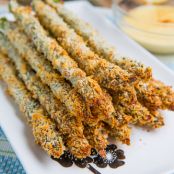Salt and Sugar-Cured Asparagus, Poached in Butter
By blum099
by Melissa Clark ·May 14, 2011
Every spring, I get so caught up in the burgeoning of my local farmers’ market that I completely forget there might be other, more far-flung delicacies to savor. White asparagus, for example.
I have no trouble getting my fill of the green stalks, which have a near vegetable monopoly on the market from early May to late June. But their paler, milder relatives just don’t seem to factor into my personal asparagus equation at all.
I suppose a little of it is the out-of-sight-out-of-mind phenomenon.
White asparagus is never on offer at my farmers’ market. In fact, this is true in most of the country, since the majority of the white asparagus we get is grown in Europe. Germany, Austria, Holland and France are famous for their fat, moon-colored stalks, which are so esteemed in those countries that entire festivals exist to celebrate their harvest.
What makes a white asparagus different from a green one is the way the plant is cultivated. Green asparagus are allowed to grow tall and exposed, basking in the sun and turning positively purple at the tips. White ones are buried under a loose hillock of soil as they sprout. This keeps the sunlight from reaching the stalks, preventing photosynthesis. Because of this rather stifling treatment, white asparagus tend to be sweeter, milder, and more tender than green ones.
All white asparagus should be peeled to rid them of their bitter skins. Then you can cook them like the green ones – roasted, steamed, sautéed, grilled, even shaved raw into salads.
Or, you can try my current favorite technique for asparagus-cooking of every hue – curing them in salt and sugar, then poaching them in butter.
I picked up the recipe from Shea Gallante, the chef at the marvelous Ciano in Manhattan’s Flatiron district. He started curing asparagus as a way to intensify their sweetness, which happens when the salt draws out some of the moisture while the sugar seasons them. Once the stalks are prepped (and it only takes 15 minutes), he cooks them slowly submerged in butter, flavored delicately with garlic.
The asparagus emerge silky-textured and profoundly, richly flavored.
Either white or green will work with this method, or use them in combination. Not only is it the prettiest way to go, it’s also the most delectable, with the bright grassiness of the green asparagus contrasting with the mellow sweetness of the white.
It may not be the most locally sourced dish in your spring rotation, but I promise it will be one of the most memorable
Ingredients
- 1 3/4 pounds white asparagus and green asparagus
- 3 tablespoons coarse kosher salt
- 3 tablespoons sugar
- 1 cup butter, melted, plus additional if needed
- 1 cup extra-virgin olive oil, plus additional if needed
- 3 garlic cloves, peeled and smashed
- Snipped chives, for garnish
Details
Servings 4
Preparation
Step 1
1. Trim the dry ends of all the asparagus and peel the white asparagus only, up to the tips. Place the asparagus on a baking rack set over a baking sheet, and sprinkle salt and sugar all over the asparagus, being careful to coat it on all sides. Let it sit for 15 minutes, then brush off the salt and sugar off using a damp paper towel or a cloth. Place the asparagus in a large skillet in one layer and add the butter and oil to cover the asparagus completely. If the above amounts are not enough to cover, add more equal parts of melted butter and oil. Add the garlic cloves.
2. Over medium heat, bring the mixture to barely a simmer, then immediately reduce heat to low and braise for 10-15 minutes, until the asparagus is tender when pierced with a fork.
3. Remove asparagus from the poaching liquid and serve as is, or topped with some snipped chives.
You can eat the garlic if you like. It will still have a bite but I like it mashed on bread with plenty of the poaching butter still clinging.
And speaking of, make sure to save the butter-oil mixture and use it for sautéing chicken, seafood and fish. It’s especially nice with shrimp. Or mash it into boiled potatoes. Or, try it as a dip for lobster instead of the usual drawn butter. I’ve never done this but can taste it in my head, and I think it’s going to be amazing.
You'll also love
-
 Cajun Cauliflower Rice
0/5
(0 Votes)
Cajun Cauliflower Rice
0/5
(0 Votes)
-
 Polynesian Pork With Pineapple Rice
0/5
(0 Votes)
Polynesian Pork With Pineapple Rice
0/5
(0 Votes)
-
 Turkey Eggplant Casserole
0/5
(0 Votes)
Turkey Eggplant Casserole
0/5
(0 Votes)
-
 Rigatoni a la Vodka, Chicken and...
0/5
(0 Votes)
Rigatoni a la Vodka, Chicken and...
0/5
(0 Votes)



Review this recipe